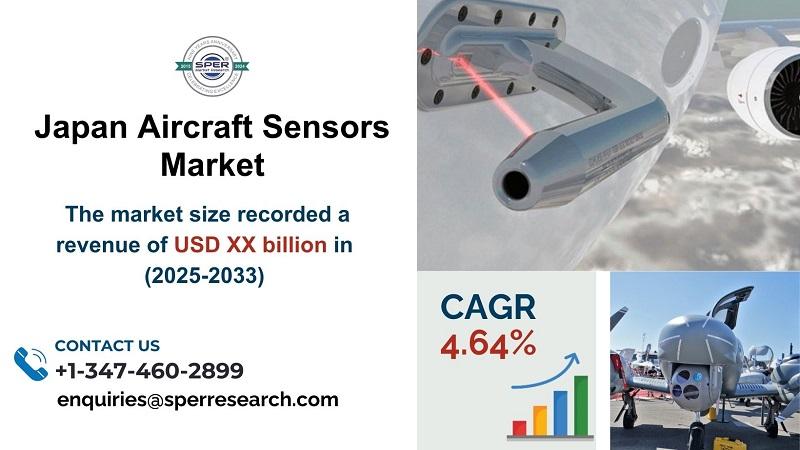Notifications

6 minutes, 10 seconds
-19 Views 0 Comments 0 Likes 0 Reviews

An aircraft sensor is a device that detects, measures, and transmits information about different physical and environmental characteristics, including altitude, airspeed, temperature, pressure, and position. These sensors are critical to assuring flight safety, performance, and navigation by giving precise real-time data to pilots and onboard systems. They provide services such as autopilot, engine monitoring, weather detection, and structural health evaluation, making them critical for both manual and automated aircraft operations.
According to SPER market research, ‘Japan Aircraft Sensors Market Size- By Aircraft Type, By Sensor Type, By Connectivity, By Application, By End User- Regional Outlook, Competitive Strategies and Segment Forecast to 2033’ state that the Japan Aircraft Sensors Market Size is predicted to reach XX billion by 2033 with a CAGR of 4.64%
Drivers: Small devices known as Micro-Electro-Mechanical Systems (MEMS) combine computers, actuators, and sensors to create an intelligent system. This MEMS's high-end, reasonably priced characteristics increase performance and prolong life in aerospace applications. In addition to lowering drag and doing away with conventional flight control surfaces, it may improve compressor, turbine, and overall aerodynamic performance. When compared to conventional systems, it offers notable advantages in terms of weight, cost, and size.
Unmanned Aerial Vehicles (UAVs) employ a variety of sensors to gather data or enhance vehicle performance. In addition to standard sensors like flow and level, temperature and pressure, and flight control, other UAVs incorporate cutting-edge technologies like LIDAR sensors for vision and navigation.
The market is anticipated to increase as a result of the growing use of UAVs in military surveillance, intelligence, and reconnaissance missions across the globe. The market's expansion is also anticipated to be driven by the rising need for UAVs for missions that pose a threat to human life and contemporary welfare practices.
Restraints: The biggest barrier to the aircraft sensor business is the exorbitant cost of the most advanced sensors. As technology progresses, the cost of manufacturing and servicing such sensors rises, particularly for small and medium-sized aircraft manufacturers. While highly precise and dependable modern infrared, radar, and fibre optic sensors exist, their production requires the use of specialised materials and complex methods. These features make them more expensive than traditional sensors, making them less affordable across all market sectors. The significant initial expenditure required to procure and operate modern sensors proves too expensive for airlines and aircraft operators, especially if the sensors are to be installed on a large number of aircraft. Installing new sensors on older aircraft fleets incurs additional installation and maintenance expenses.
Request a Free Sample Report: https://www.sperresearch.com/report-store/japan-aircraft-sensors-market.aspx?sample=1
The Chūbu region dominates the Japanese aircraft market. Because of its robust industrial foundation, integration with international aerospace supply chains, and significant government and private sector investment in R&D and manufacturing capacity, the Chūbu region dominates the Japanese aircraft market. Some of the key market players are Honeywell Aerospace Japan, Japan Aviation Electronics Ltd. (JAEL), Murata Manufacturing Co., Ltd. and others.
Japan Aircraft Sensors Market Segmentation:
By Aircraft Type: Based on the Aircraft Type, Japan Aircraft Sensors Market is segmented as; Fixed Wings, Rotorcraft, Others.
By Sensor Type: Based on the Sensor Type, Japan Aircraft Sensors Market is segmented as; Proximity Sensors, Temperature Sensors, Optical Sensors, Pressure Sensors, Force Sensors, Flow Sensors, Radar Sensors, Others.
By Connectivity: Based on the Connectivity, Japan Aircraft Sensors Market is segmented as; Wired Sensors, Wireless Sensors.
By Application: Based on the Application, Japan Aircraft Sensors Market is segmented as; Flight Decks, Landing Gear Systems, Weapon Systems, Fuel, Hydraulic, and Pneumatic Systems, Engine/Propulsion, Cabin and Cargo Environmental Controls, Aerostructures and Flight Control, Others.
By End Use: Based on the End Use, Japan Aircraft Sensors Market is segmented as; OEM, Aftermarket.
By Region: This research also includes data for Kanto Region, Kansai/Kinki Region, Central/ Chubu Region, Kyushu-Okinawa Region, Tohoku Region, Chugoku Region, Hokkaido Region.
For More Information, refer to below link: –
Japan Aircraft Sensors Market Outlook
Related Reports:
Follow Us –
LinkedIn | Instagram | Facebook | Twitter
Contact Us:
enquiries@sperresearch.com
+1–347–460–2899
Japan Aircraft Sensors Market Japan Aircraft Sensors Market Growth Japan Aircraft Sensors Market Size Japan Aircraft Sensors Market Trends Japan Aircraft Sensors Market Share Japan Aircraft Sensors Market Revenue Japan Aircraft Sensors Market Demand Japan Aircraft Sensors Market Challenges Japan Aircraft Sensors Market Competition Japan Aircraft Sensors Market Report

